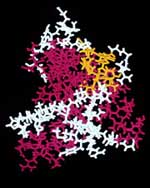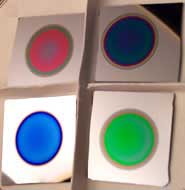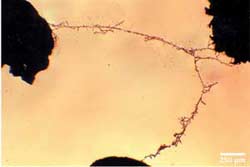
A gene may protect people against variant Creutzfeldt-Jakob disease.
People who lack a gene involved in immune responses may be three times more likely to suffer from variant Creutzfeldt-Jakob disease (vCJD), a new study suggests1. The result, if borne out in larger studies, could point researchers toward therapies for the incurable brain disease.
vCJD is thought to occur when people are exposed to misshapen prion proteins from cows with bovine spongiform encephalopathy – B

New catalyst means greener paper is not pulp fiction.
Pollution from paper production could be cut, say US chemists, with a new way of refining wood pulp 1 . But the process must go through the mill before it can convert industry.
During paper production, gluey wood component lignin is stripped out to leave stringy cellulose. The harsh chemicals used create environmental pollutants, such as toxic and long-lasting chlorinated compounds.
A new chemical
Scientists are finally beginning to understand how common genetic differences among individuals underlie differences in the structures that make up their brains. In the first attempt to actually map these variations, neurologist Paul Thompson and colleagues at the University of California at Los Angeles have discovered that brain structures related to cognitive ability and language seem to be under tight genetic control. The group’s findings, which could help explain how diseases like schizophre

A microelectronic sensor may alert doctors to bacterial hazards.
Smart bandages could soon alert doctors to the presence of certain bacteria in a wound by glowing different colours. Researchers in the United States have created a tiny device that emits faint light of two colours in response to two types of bug 1 .
Benjamin Miller, of the University of Rochester in New York State, and colleagues hope that a refined sensor might ultimately generate an instant an

Solar cells printed like wallpaper.
Solar cells might one day be produced by the roll, as cheaply and easily as wallpaper. Scientists in Arizona are using screen-printing, a technique developed for patterning fabrics, to produce plastic solar cells 1 .
The technique is another step towards the general availability of solar power from flexible devices on plastic sheets or glass panels. The basic materials of a photovoltaic cell are inexpensive, but combining t

Scientists can coax tiny metal particles to self-assemble into microscopic wires that conduct electricity and repair themselves, new research reveals. Kevin D. Hermanson of the University of Delaware and his colleagues, who published their finding in the current issue of Science, suggest that such nanowires may prove useful for wet electronic and bioelectric circuits.
The researchers placed particles of gold ranging in diameter from 15 to 30 nanometers in a fluid suspension within a thin ch